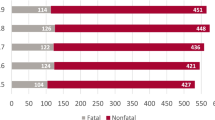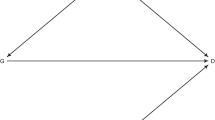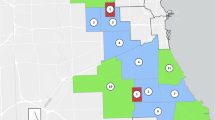Abstract
Using a single source of data, such as police records, or combining data from multiple sources results in an undercount of gun-related injuries. To improve gun-related injury surveillance accuracy by using capture–recapture methods, data were culled from law enforcement, emergency departments, emergency medical services, media, and medical examiner records. The data overlap was operationalized using capture–recapture to generate estimates of uncounted gun incidents. Dependencies between data sources were controlled using log-linear modeling for accurate estimates. New Haven, Connecticut. The study population included subjects injuried/killed from a gun projectile. Incidence was measured using capture–recapture. 49 gun injuries occurred within the defined geography. No single source recorded more than 43 gun-related injuries/deaths. Log-linear modeling estimated the actual number of injuries to be 49.1 (95% CI 49–49.9). Capture–recapture may be less useful in large metropolitan areas that cross state geographical boundaries because of how government agency data are aggregated within each state. No single data source achieves complete gun-related case ascertainment. Log-linear and capture–recapture methods significantly improve gun-related injury estimates.


Similar content being viewed by others
References
Bohning, D., van der Heijden, P. G., & Bunge, J. (2017). Capture–recapture methods for the social and medical sciences. Cambridge: CRC Press.
Buckland, S. T., & Morgan, B. J. (2016). 50-year anniversary of papers by Cormack, Jolly and Seber. Statistical Science, 31, 141.
CDC. (2018). WONDER: Underlying Cause of Death. Underlying Cause of Death, 1999-2017. Retrieved from https://wonder.cdc.gov/controller/datarequest/D76
CDC. (2019). WISQARS nonfatal Injury Reports. Nonfatal Injury Reports, 2000–2016. Retrieved from https://webappa.cdc.gov/sasweb/ncipc/nfirates.html
Charette, Y., & van Koppen, V. (2016). A capture–recapture model to estimate the effects of extra-legal disparities on crime funnel selectivity and punishment avoidance. Security Journal, 29, 561–583.
Duquet, N., & Alstein, M. V. (2015). Firearms and violent deaths in Europe. Retrieved from Europe: https://www.vlaamsvredesinstituut.eu/sites/vlaamsvredesinstituut.eu/files/files/reports/firearms_and_violent_deaths_in_europe_web.pdf
Feldman, J. M., Gruskin, S., Coull, B. A., & Krieger, N. (2017). Quantifying underreporting of law-enforcement-related deaths in United States vital statistics and news-media-based data sources: A capture–recapture analysis. PLoS Medicine, 14, e1002399.
Gabor, T. (2016). Confronting gun violence in America. Berlin: Springer.
Garcia, M. (2011). Creating a healthy and safe city: The impact of violence in New Haven. Retrieved from New Haven, CT:
Gold, S. J., Wibert, W. N., Bondartsova, V., Biroscak, B. J., & Post, L. A. (2015). A capture–recapture approach to estimation of refugee populations. International Migration, 53, 3–25.
Grinshteyn, E., & Hemenway, D. (2016). Violent death rates: the US compared with other high-income OECD countries, 2010. The American Journal of Medicine, 129, 266–273.
Hemenway, D. (1996). Survey research and self-defense gun use: An explanation of extreme overestimates. Journal of Criminal Law and Criminology, 87, 1430.
Kellermann, A. L., Rivara, F. P., Lee, R. K., Banton, J. G., Cummings, P., Hackman, B. B., et al. (1996). Injuries due to firearms in three cities. The New England Journal of Medicine, 335, 1438–1444.
Kellermann, A. L., Rivara, F. P., Rushforth, N. B., Banton, J. G., Reay, D. T., Francisco, J. T., et al. (1993). Gun ownership as a risk factor for homicide in the home. The New England Journal of Medicine, 329, 1084–1091.
Kleck, G. (2017a). Point blank: Guns and violence in America. London: Routledge.
Kleck, G. (2017b). Targeting guns: Firearms and their control. London: Routledge.
Miller, T. R., Lawrence, B. A., Carlson, N. N., Hendrie, D., Randall, S., Rockett, I. R., et al. (2016). Perils of police action: a cautionary tale from US data sets. Injury Prevention, injuryprev-2016-042023.
National Research Council. (2005). Firearms and violence: A critical review. Washington, DC: The National Academies Press.
Pah, A., Hagan, J., Jennings, A., Jain, A., Albrecht, K., Hockenberry, A., et al. (2017). Economic insecurity and the rise in gun violence at US schools. Nature Human Behaviour, 1, 0040.
Post, L. A., Mezey, N. J., Maxwell, C. D., & Rhodes, K. (2011). Using capture–recapture to estimate the prevalence of intimate partner violence: The gender symmetry debate. International Journal of Science in Society, 2, 223–235.
Rivest, L., & Baillargeon, S. (2014). Rcapture: Loglinear models for capture–recapture experiments. R package version 1.4-2.
Rothman, E. F., Stoklosa, H., Baldwin, S. B., Chisolm-Straker, M., Kato Price, R., Atkinson, H. G., et al. (2017). Public health research priorities to address US human trafficking: American Public Health Association.
Straus, M. A. (2017). Physical violence in American families: Incidence rates, causes, and trends. In Abused and battered (pp. 17–34). Routledge.
US Cenus Bureau. (2019). American Community Survey. Retrieved from https://factfinder.census.gov/faces/nav/jsf/pages/index.xhtml
Author information
Authors and Affiliations
Corresponding author
Ethics declarations
Conflict of interest
Lori Ann Post, Zev Balsen, Richard Spano, and Federico E. Vaca declare that they have no conflict of interest.
Human and animal rights and Informed consent
All procedures performed in studies involving human participants were in accordance with the ethical standards of the institutional and/or national research committee and with the 1964 Helsinki declaration and its later amendments or comparable ethical standards. For this type of study formal consent is not required.
Ethical standards
This study relied on secondary data analysis and thus informed consent was unnecessary. All identifiers were deleted from database and data only are presented in the aggregate. There were no human participants or animals. This study was reviewed and approved by Northwestern and Yale Universities, and University of New Haven IRBs as it was exempt. This study was unfunded.
Additional information
Publisher's Note
Springer Nature remains neutral with regard to jurisdictional claims in published maps and institutional affiliations.
Rights and permissions
About this article
Cite this article
Post, L.A., Balsen, Z., Spano, R. et al. Bolstering gun injury surveillance accuracy using capture–recapture methods. J Behav Med 42, 674–680 (2019). https://doi.org/10.1007/s10865-019-00017-4
Received:
Accepted:
Published:
Issue Date:
DOI: https://doi.org/10.1007/s10865-019-00017-4




